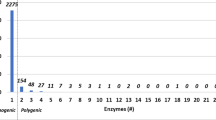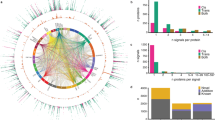Abstract
One important challenge in the post-genomic era is uncovering the relationships among distinct pathophenotypes by using molecular signatures. Given the complex functional interdependencies between cellular components, a disease is seldom the consequence of a defect in a single gene product, instead reflecting the perturbations of a group of closely related gene products that carry out specific functions together. Therefore, it is meaningful to explore how the community of protein complexes impacts disease associations. Here, by integrating a large amount of information from protein complexes and the cellular basis of diseases, we built a human disease network in which two diseases are linked if they share common disease-related protein complex. A systemic analysis revealed that linked disease pairs exhibit higher comorbidity than those that have no links, and that the stronger association two diseases have based on protein complexes, the higher comorbidity they are prone to display. Moreover, more connected diseases tend to be malignant, which have high prevalence. We provide novel disease associations that cannot be identified through previous analysis. These findings will potentially provide biologists and clinicians new insights into the etiology, classification and treatment of diseases.
Similar content being viewed by others
Log in or create a free account to read this content
Gain free access to this article, as well as selected content from this journal and more on nature.com
or
References
Barabasi AL, Oltvai ZN : Network biology: understanding the cell’s functional organization. Nat Rev Genet 2004; 5: 101–113.
Friedman A, Perrimon N : Genetic screening for signal transduction in the era of network biology. Cell 2007; 128: 225–231.
Barabasi AL, Gulbahce N, Loscalzo J : Network medicine: a network-based approach to human disease. Nat Rev Genet 2011; 12: 56–68.
Oti M, Brunner HG : The modular nature of genetic diseases. Clin Genet 2007; 71: 1–11.
Barabasi AL : Network medicine from obesity to the ‘diseasome’. N Engl J Med 2007; 357: 404–407.
Loscalzo J, Kohane I, Barabasi AL : Human disease classification in the postgenomic era: a complex systems approach to human pathobiology. Mol Syst Biol 2007; 3: 124.
de Winter JP, van der Weel L, de Groot J et al. The Fanconi anemia protein FANCF forms a nuclear complex with FANCA, FANCC and FANCG. Hum Mol Genet 2000; 9: 2665–2674.
D'Andrea AD : The Fanconi anemia/BRCA signaling pathway: disruption in cisplatin-sensitive ovarian cancers. Cell Cycle 2003; 2: 290–292.
Lamb J, Crawford ED, Peck D et al. The connectivity map: using gene-expression signatures to connect small molecules, genes, and disease. Science 2006; 313: 1929–1935.
Lage K, Karlberg EO, Storling ZM et al. A human phenome-interactome network of protein complexes implicated in genetic disorders. Nat Biotechnol 2007; 25: 309–316.
Goh KI, Cusick ME, Valle D, Childs B, Vidal M, Barabasi AL : The human disease network. Proc Natl Acad Sci USA 2007; 104: 8685–8690.
Lee DS, Park J, Kay KA, Christakis NA, Oltvai ZN, Barabasi AL : The implications of human metabolic network topology for disease comorbidity. Proc Natl Acad Sci USA 2008; 105: 9880–9885.
Hamosh A, Scott AF, Amberger JS, Bocchini CA, McKusick VA : Online Mendelian Inheritance in Man (OMIM), a knowledgebase of human genes and genetic disorders. Nucleic Acids Res 2005; 33: D514–D517.
Park J, Lee DS, Christakis NA, Barabasi AL : The impact of cellular networks on disease comorbidity. Mol Syst Biol 2009; 5: 262.
Ruepp A, Waegele B, Lechner M et al. CORUM: the comprehensive resource of mammalian protein complexes. Nucleic Acids Res 2009; 38: D497–D501.
Mewes HW, Dietmann S, Frishman D et al. MIPS: analysis and annotation of genome information in 2007. Nucleic Acids Res 2008; 36: D196–D201.
Lauderdale DS, Furner SE, Miles TP, Goldberg J : Epidemiologic uses of Medicare data. Epidemiol Rev 1993; 15: 319–327.
Mitchell JB, Bubolz T, Paul JE et al. Using Medicare claims for outcomes research. Med Care 1994; 32: JS38–JS51.
Hidalgo CA, Blumm N, Barabasi AL, Christakis NA : A dynamic network approach for the study of human phenotypes. PLoS Comput Biol 2009; 5: e1000353.
Thissen D, Steinberg L, Kuang D : Quick and easy implementation of the Benjamini-Hochberg procedure for controlling the false positive rate in multiple comparisons. J Educ Behav Stat 2002; 27: 77–83.
Li Y, Agarwal P : A pathway-based view of human diseases and disease relationships. PLoS One 2009; 4: e4346.
Szilagyi A, Grimm V, Arakaki AK, Skolnick J : Prediction of physical protein-protein interactions. Phys Biol 2005; 2: S1–16.
Cai L, Xue H, Lu H, Zhao Y, Zhu X, Bu D, Ling L, Chen R : Analysis of correlations between protein complex and protein-protein interaction and mRNA expression. Chinese Sci Bull 2003; 48: 2226–2230.
Yunku Yeu J, Youngmi Y, Sanghyun P : Protein complex discovery from protein interaction network with high false-positive rate. Lect Notes Comput Sci 2011; 6623: 177–182.
American Cancer Society 2011: Cancer Facts and Figures 2011 2011.
Wallace JD, Levy LL : Blood pressure after stroke. JAMA 1981; 246: 2177–2180.
Hachinski V : Hypertension in acute ischemic strokes. Arch Neurol 1985; 42: 1002.
Thomas MC, MacIsaac RJ, Tsalamandris C, Power D, Jerums G : Unrecognized anemia in patients with diabetes: a cross-sectional survey. Diabetes Care 2003; 26: 1164–1169.
Mulligan HD, Beck SA, Tisdale MJ : Lipid metabolism in cancer cachexia. Br J Cancer 1992; 66: 57–61.
Shaw RJ : Glucose metabolism and cancer. Curr Opin Cell Biol 2006; 18: 598–608.
Cottier H, Hess MW, Walti ER : Immunodeficiency and cancer: mechanisms involved. Schweiz Med Wochenschr 1986; 116: 1119–1126.
Hadden JW : Immunodeficiency and cancer: prospects for correction. Int Immunopharmacol 2003; 3: 1061–1071.
Acknowledgements
This research was supported by the National Natural Science Foundation of China (grant nos. 31100948, 30871394 and 91029717), the National Science Foundation of Heilongjiang Province (grant nos. D201114, QC2009C23), the Science Foundation of Educational Commission of Heilongjiang Province (grant no. 11551233), the Graduate Innovation Fund of Heilongjiang Province (grant nos. YJSCX2011-334HLJ and YJSCX2009-226HLJ).
Author information
Authors and Affiliations
Corresponding author
Ethics declarations
Competing interests
The authors declare no conflict of interest.
Additional information
Supplementary Information accompanies the paper on European Journal of Human Genetics website
Supplementary information
Rights and permissions
About this article
Cite this article
Wang, Q., Liu, W., Ning, S. et al. Community of protein complexes impacts disease association. Eur J Hum Genet 20, 1162–1167 (2012). https://doi.org/10.1038/ejhg.2012.74
Received:
Revised:
Accepted:
Published:
Issue date:
DOI: https://doi.org/10.1038/ejhg.2012.74
Keywords
This article is cited by
-
A New Framework for Discovering Protein Complex and Disease Association via Mining Multiple Databases
Interdisciplinary Sciences: Computational Life Sciences (2021)
-
Quantitative analysis of proteins which are members of the same protein complex but cause locus heterogeneity in disease
Scientific Reports (2020)
-
HGPEC: a Cytoscape app for prediction of novel disease-gene and disease-disease associations and evidence collection based on a random walk on heterogeneous network
BMC Systems Biology (2017)
-
Investigation of coordination and order in transcription regulation of innate and adaptive immunity genes in type 1 diabetes
BMC Medical Genomics (2017)
-
Understanding cancer complexome using networks, spectral graph theory and multilayer framework
Scientific Reports (2017)



